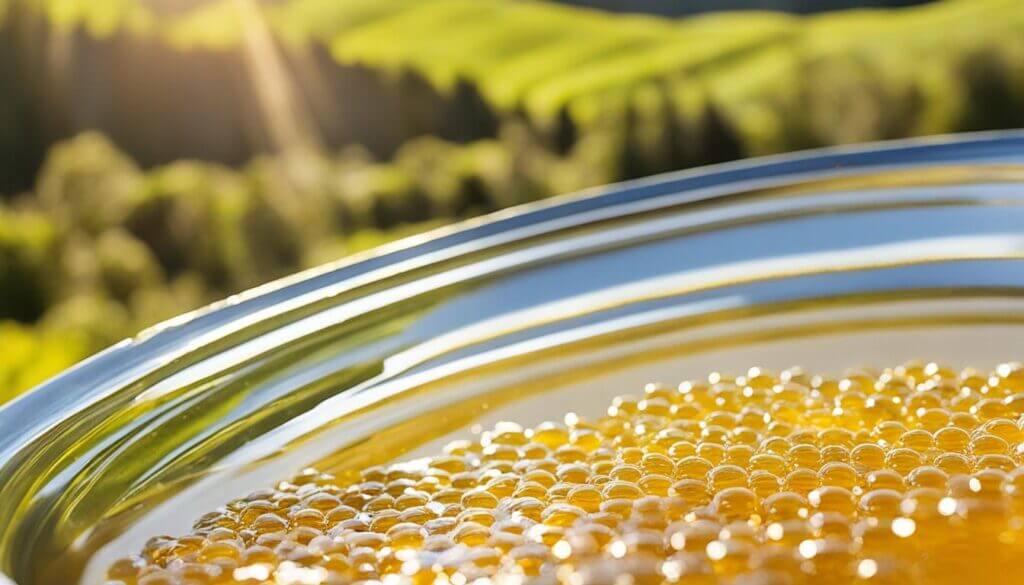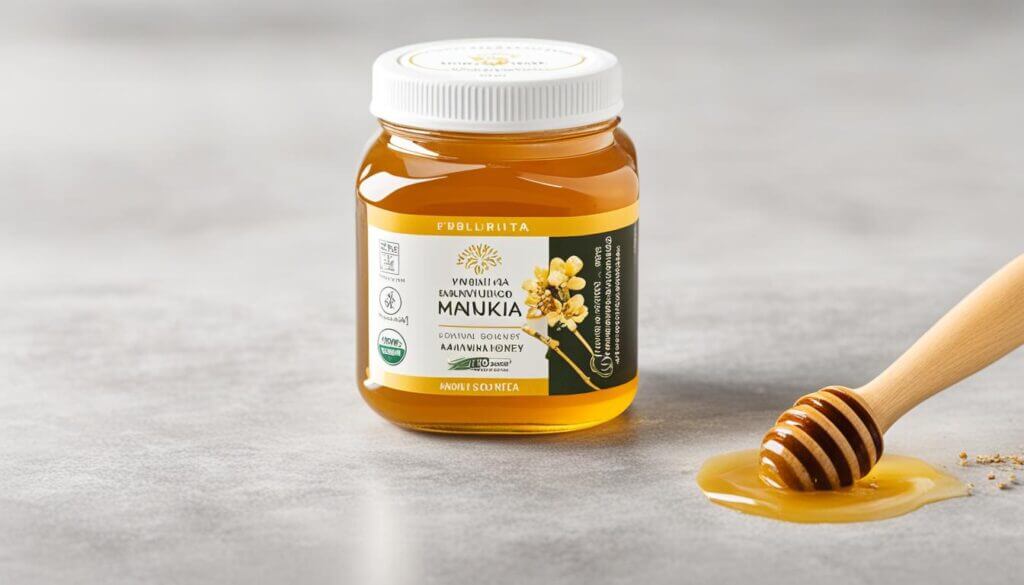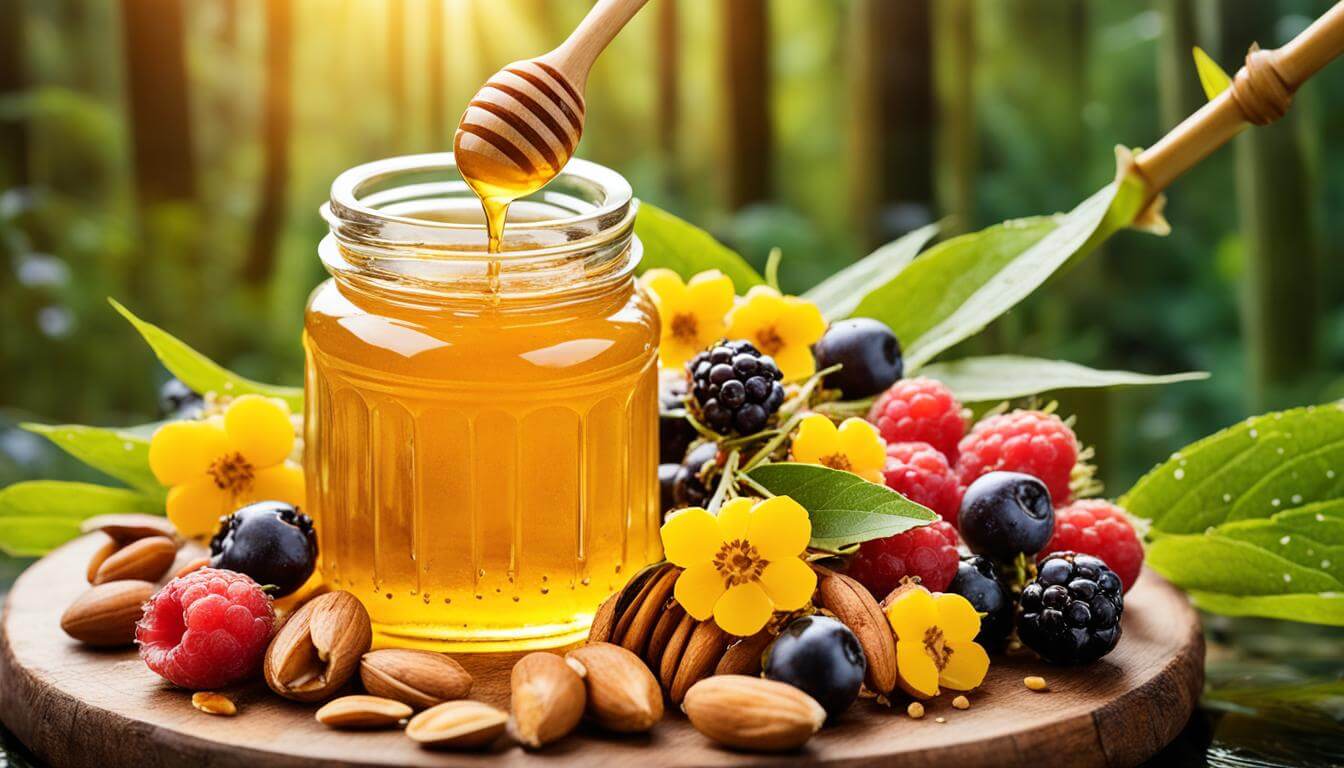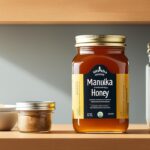While satisfaction often comes sweetened, managing blood sugar levels remains a delicate dance for health-conscious individuals, particularly those with diabetes. The global quest for low-GI sweeteners has brought Manuka honey into the spotlight, not just as a delectable treat but as a potential ally in this balancing act. But how does this unique honey from New Zealand measure up when it comes to Manuka honey health benefits and the glycemic index?
Oft-touted as a health elixir, Manuka honey’s reputation precedes it, promising a natural subterfuge to blood sugar spikes. The questions are pressing: can Manuka honey live up to its fame as a sweetener that melds pleasure with health? And more importantly, could this luscious liquid gold be the key to not only sweetening your palate but also managing blood sugar levels successfully?
In the pursuit of wellness, let’s uncap the jar of mysteries that is Manuka honey and explore if it truly is a viable part of a low-GI diet. Join us as we delve into the science and explore this nectar’s nutritive nectar—decanting facts from folklore and sweetness from science.
What is the Glycemic Index?
The concept of the glycemic index (GI) is critical for understanding the blood sugar impact of foods. Defined as a ranking system, it categorizes carbohydrates based on their effect on our blood glucose levels. The GI is utilized by individuals looking to manage their dietary choices to enhance health and by healthcare professionals advising patients on nutrition.
But how does the GI scale work? Imagine it as a measure, running from low to high, its purpose to indicate how swiftly sugars are released into the bloodstream. When you consume a food with a high GI ranking, your body experiences a rapid increase in blood sugar levels, whereas low glycemic foods lead to a slower, more controlled release of sugar, ensuring a steadier energy balance.
Low GI foods are more than just buzzwords for health enthusiasts. Their importance lies in their ability to provide sustained energy, reduce hunger pangs, and aid in the maintenance of blood sugar levels—a harmonious trifecta for overall well-being.
| GI Category | GI Range | Impact on Blood Sugar |
|---|---|---|
| Low GI | 55 or less | Slow release of sugar |
| Medium GI | 56 – 69 | Moderate release of sugar |
| High GI | 70 or higher | Rapid release of sugar |
Choosing low glycemic foods over those with a high GI ranking is not merely a matter of dietary preference but a conscious decision impacting long-term health outcomes. By opting for foods that maintain a balanced glucose level, one can effectively manage energy levels, curb excess appetite, and support metabolic health.
Origins and Properties of Manuka Honey
Renowned for its distinctive characteristics, New Zealand Manuka honey is a premium product that stands out in the global market. This honey is made by bees that pollinate the native Manuka bush, known scientifically as Leptospermum scoparium, a plant indigenous to New Zealand. Its uniqueness is attributed to the Methylglyoxal (MGO) compound which offers remarkable bacterial resistance, separating it from conventional honey varieties.
The UMF rating, or Unique Manuka Factor, is a hallmark of purity and quality in Manuka honey, akin to a seal of excellence. This grading system certifies the presence of specific natural markers, such as MGO and a handful of others, that together indicate the honey’s potency and ensure its authenticity. The higher the UMF number, the more potent the antimicrobial properties of the Manuka honey are believed to be, giving consumers a way to gauge the therapeutic potency they desire.
- UMF 5+ indicates the presence of at least 83 mg/kg of Methylglyoxal.
- UMF 10+ is a mid-range level suitable for general wellness purposes.
- UMF 15+ and above are considered superior grades with strong therapeutic properties.
People around the world seek out Manuka honey characteristics not only for its unique taste but also for its health benefits. While all honeys have beneficial properties stemming from their floral origins, Manuka’s unique components have placed it in high demand. Among these, its hydrogen peroxide, MGO, and dihydroxyacetone content have been extensively studied and linked to its much-vaunted health features.

The exploration of Manuka honey’s origins and properties underscores why it has been cherished for centuries by the indigenous Maori people of New Zealand, used both as a food source and in traditional remedies. In modern times, its reputation has only grown, as scientific studies continue to validate its esteemed status amongst naturals health products.
Manuka Honey Glycemic Index
Manuka honey has captivated the interest of health enthusiasts all over the world, not just for its rich flavor and unique properties, but also for its medium glycemic index (GI) value. As a natural sweetener, the GI value of Manuka honey reflects its ability to raise blood glucose levels at a steadier pace compared to high-GI alternatives. This characteristic makes it a more suitable option for those monitoring their sugar intake.
When considering the natural sweetener glycemic levels, Manuka honey typically showcases a GI value that categorizes it as a medium GI food. The exact GI can vary due to multiple factors such as the honey’s botanical source, maturity, and processing techniques, all of which can influence the final glycemic index.
| Sweetener | Glycemic Index |
|---|---|
| Manuka Honey | 55-65 |
| Table Sugar (Sucrose) | 63-68 |
| High-Fructose Corn Syrup | 73-90 |
Manuka honey’s position on the GI scale emphasizes its advantage over common sweeteners like table sugar and high-fructose corn syrup, which can rapidly spike glucose levels in the bloodstream. The multifactorial impact on Manuka honey GI value ensures complexity and requires consumers to consider the honey’s origin and processing before consumption. Ultimately, Manuka honey remains a preferential choice for those seeking sweetness with moderated impacts on blood sugar levels.
Why Glycemic Index Matters for Your Health
Understanding the glycemic index is crucial in managing diabetes and preventing pre-diabetes from escalating. The glyecemic index (GI) is a measure that ranks foods on how they affect blood glucose levels, playing a pivotal role in maintaining stable blood sugar. A low-GI diet promotes a more stable energy release, curbing rapid spikes in glucose, which is especially beneficial for those managing diabetes, insulin sensitivity, and related health conditions.
Moreover, the regular consumption of high-GI foods is directly linked to an increased risk of obesity and cardiovascular diseases. These foods cause sudden elevations in blood sugar, leading to insulin resistance over time. High insulin levels are associated with a higher risk of heart disease, thus making GI a key factor to consider for a heart-healthy diet.
Integrating low-GI foods into one’s diet can offer a multitude of low-GI diet benefits. These foods provide a slow and consistent source of energy, which keeps hunger at bay, helps in weight management, and controls cravings. This is vital for long-term health and wellbeing, reducing the temptation to reach for those quick, sugary fixes that contribute to poor health outcomes.

- Improved cholesterol levels, reducing the risk of heart disease.
- Sustainable weight management through controlled appetite and reduced hunger pangs.
- Enhanced concentration and mood stability due to better blood sugar control.
- Decreased risk of developing type 2 diabetes by aiding in blood sugar regulation.
To further illustrate the importance of the glycemic index in one’s diet, here’s a comparative table showing the GI value of common foods:
| Food Item | Glycemic Index (GI) | Benefits of Low-GI |
|---|---|---|
| Oats | 55 | Long-lasting satiety, reduced cholesterol. |
| Lentils | 30 | Controlled blood sugar rise, high fiber content. |
| Apple | 36 | Slow energy release, gut health support. |
| White Bread | 73 | — |
| Potato Chips | 56 | — |
| Carrots | 39 | Steady glucose absorption, nutrient-rich. |
In conclusion, being mindful of the glycemic index, understanding its significance, and choosing suitable low-GI foods can enhance your health, control blood sugar, and offer a sustainable source of energy.
Comparative Glycemic Analysis: Manuka vs. Other Sweeteners
When making healthier dietary choices, understanding the glycemic impact of various sweeteners is crucial. With an increasing number of sugar alternatives on the market, the Sweetener GI comparison becomes an essential tool for managing health and dietary needs. Manuka honey, renowned for its unique properties, stands out amongst a myriad of natural and artificial sweeteners.
The Glycemic Load (GL) is another vital measurement, providing insight into how much a serving of food is likely to increase blood sugar levels. It factors in the amount of carbohydrate in a portion of food along with the GI, offering a more nuanced approach to dietary management.
- Glycemic Index (GI) measures the rate at which carbohydrates raise blood sugar
- Glycemic Load (GL) considers both the quantity of carbohydrate and the GI of the food
Differences in GI and GL between Manuka honey and other sweeteners can significantly affect blood sugar stability. Studies highlight that natural sweeteners like Manuka often have a more favorable glycemic profile compared to refined sugars and high-fructose corn syrup. Below is a comparison that sheds light on the variations in GI and GL among popular sweetener options.
| Sweetener | Glycemic Index | Glycemic Load (Per Serving) |
|---|---|---|
| Manuka Honey | Medium GI | Varies based on serving size |
| Table Sugar (Sucrose) | High GI | Higher than Manuka |
| Maple Syrup | Medium to High GI | Similar or higher than Manuka |
| Agave Nectar | Low GI | Lower than Manuka |
| Stevia | Low GI | Minimal to none |
| High-fructose Corn Syrup | High GI | Higher than Manuka |
It’s evident that while artificial sweeteners may boast a low GI, their lack of nutritive value and potential adverse health effects make them less desirable. On the other hand, Manuka honey, along with some other natural sweeteners, provides both sweetness and beneficial nutrients with a moderate effect on blood sugar levels.
Knowing how to incorporate these options responsibly into one’s diet requires a balanced approach and an understanding of one’s personal health goals. Incremental changes towards sugar alternatives with a lower and healthier GI and GL can aid in maintaining stable blood sugar levels, thus providing an edge in overall well-being.
Manuka Honey: More Than Just a Sweetener
While renowned for its rich flavor, Manuka honey’s acclaim lies not only in its culinary attributes but also in its impressive therapeutic uses. Famed for its anti-inflammatory properties, Manuka honey offers relief in various inflammatory conditions, such as sore throats and digestive upset. Its antioxidant benefits also play a crucial role in combatting free radicals, substances known to accelerate aging and increase the risk of chronic diseases.
Extending far beyond the kitchen, Manuka honey applies its healing prowess in clinical settings, particularly in wound care. Due to its high viscosity, it forms a protective barrier, promoting moist wound healing—which is crucial for tissue regeneration—while its antimicrobial properties help prevent infection. Additionally, Manuka honey’s contributions to enhancing overall immunity have made it a staple in natural remedy circles.
Here is a concise overview of the bioactive compounds in Manuka honey that contribute to its health-promoting reputation:
| Bioactive Compound | Health Benefit |
|---|---|
| Methylglyoxal (MGO) | Antibacterial agent that provides Manuka honey with its unique antibacterial properties |
| Dihydroxyacetone (DHA) | Pre-cursor to MGO which matures into these healing compounds over time in the honey |
| Bee Defensin-1 | A molecule attributed to the immune boosting powers of Manuka honey |
| Hydrogen Peroxide | Contributes to the antiseptic quality of the honey |
| Leptosperin | Distinctive component that ensures the purity and quality of Manuka honey |
The versatility of Manuka honey in promoting healing and health preservation solidifies its status not just as a sweetener, but as a natural product of high therapeutic value.
Incorporating Manuka Honey in Everyday Nutrition
With its exceptional health properties, Manuka honey is a superb addition to the pantry of anyone looking for natural sweetening options. Adjusting Manuka honey daily intake to suit personal health goals, particularly for those managing blood sugar levels, can still deliver the flavor and benefits without overconsumption. Below are simple, transformative ways to use this unique honey in your daily routine.
- Drizzle over oatmeal or yogurt to start the day with a nutritious boost while keeping portions in check for a balanced glycemic load.
- Blend into smoothies as a natural sweetener, capitalizing on Manuka honey’s rich consistency and health benefits.
- Stir into herbal teas as a soothing, health-promoting sweetener in place of refined sugars.
Healthy recipes with Manuka honey don’t stop at sweet treats; it’s versatile enough to enhance savory dishes too. Consider these creative mixes to incorporate Manuka honey into diverse meal options:
- Create a Manuka honey balsamic dressing for salads by emulsifying equal parts honey and balsamic vinegar with a dash of olive oil.
- Use it to glaze roasted vegetables or meats, providing a subtle sweetness that caramelizes beautifully under heat.
- Mix with mustard or soy sauce for a flavorful marinade that tenderizes and infuses dishes with depth.
Understanding your daily intake is crucial, especially if monitoring sugar consumption is necessary for your diet. For reference, here is a handy table with suggested serving sizes:
| Food Item | Serving Size | Manuka Honey Amount |
|---|---|---|
| Oatmeal/Yogurt | 1 cup | 1 tablespoon |
| Smoothies | 16 oz | 2 teaspoons |
| Tea | 1 cup | 1 teaspoon |
| Salad Dressing | 3 tablespoons | 1 teaspoon |
| Glaze for Roasting | For 4 servings | 2 tablespoons |
| Marinades | For 1 lb of protein | 2 tablespoons |
By creatively integrating Manuka honey into wholesome meals, not only can you enjoy its unique taste and texture, but you also reap its health-promoting properties. Remember, moderation is key to balancing enjoyment with health benefits, making Manuka honey a sweet part of a healthy lifestyle.
Processing and Its Effects on Manuka Honey’s Glycemic Properties
The integrity of raw Manuka honey is paramount in delivering the health benefits it is renowned for, among which its impact on glycemic response is a significant aspect. Uncovering how various honey processing methods affect Manuka honey’s natural nutrients and glycemic properties is vital for consumers aiming to make informed food choices.
Raw Manuka honey, which bypasses fine-filtering and pasteurization, maintains a constellation of natural enzymes, antioxidants, and antibacterial elements, thus preserving Manuka honey nutrients. These factors contribute not only to its health properties but also influence its glycemic index (GI). The GI may be affected by the level of processing honey undergoes. Heating and filtering Manuka honey can alter enzymatic activity and destroy heat-sensitive nutrients, potentially increasing the GI.
| Processing Method | Effect on Nutrients | Potential Impact on GI |
|---|---|---|
| Raw (Unpasteurized) | High nutrient retention | Lower GI due to intact enzymes |
| Minimal Filtration | Moderate nutrient retention | May increase GI slightly |
| Pasteurization | Loss of sensitive enzymes and nutrients | Higher GI due to breakdown of complex sugars |
Consumers seeking to reap the full advantages of Manuka honey should look for products labeled as “raw” or “unpasteurized.” These terminologies ensure that the honey, packed with nutrients, has been minimally handled, thus preserving Manuka honey nutrients and keeping its natural GI as low as possible.
Identifying genuine Manuka honey with minimal processing can be aided by checking for certifications like the UMF rating, which denotes not only the quality and potency but also guarantees that the honey is free from undesired processing. Understanding labeling helps protect the consumer from paying a premium for Manuka honey that might be excessively processed and stripped of its natural goodness.

As a friendly advice, while shopping for Manuka honey, always take a moment to read the label. Look for keywords such as “raw,” “unpasteurized,” and a high UMF rating. By doing so, you ensure that you are investing in a product that retains the best possible nutrient profile and keeps to a low GI, contributing to its extensive catalog of health benefits.
Tips for Choosing and Storing Manuka Honey
When shopping for Manuka honey, it’s essential to consider its Unique Manuka Factor (UMF) rating, which ensures purity and quality, indicating its therapeutic properties. Sourced directly from New Zealand, genuine Manuka honey boasts unique health benefits. To assist you in buying Manuka honey with confidence, here are a few key points to remember.
- Check the label for the UMF trademark, and only buy honey with a UMF rating of 10 or higher, as this indicates higher levels of the beneficial compounds.
- Consider the MGO (Methylglyoxal) concentration – the magic ingredient that gives Manuka honey its antibacterial strength.
- Examine the origin. Authentic Manuka honey is produced in New Zealand; authenticity can typically be verified via a traceability system provided by reputable brands.
When it comes to storing honey, maintaining Manuka honey quality is critical to its longevity and efficacy. Here’s how you can keep your Manuka honey in its best condition:
- Store Manuka honey in a cool, dark place away from direct sunlight. A pantry or cupboard is ideal.
- Ensure the container’s lid is tightly closed to prevent moisture, which can lead to fermentation and compromise its qualities.
- Avoid using wet spoons or utensils to scoop out the honey; moisture can degrade its natural state.
It’s worth noting that crystallization is a natural process that can occur in pure honey. If your Manuka honey crystallizes, this is not a sign of spoilage. In fact, it indicates minimal processing and a high-quality product. Gently warming the honey can dissolve the crystals.
| Storage Factor | Why It Matters | Best Practice |
|---|---|---|
| Temperature | Heat can degrade the honey’s quality. | Keep in a cool place, ideally below 20°C (68°F). |
| Light Exposure | Direct sunlight can affect the color and composition. | Store in a dark place, avoiding direct sunlight. |
| Container Integrity | Air exposure can lead to honey losing its potent properties. | Use an airtight container made of glass or food-grade plastic. |
| Humidity | High humidity can lead to fermentation. | Ensure a dry environment and use a dry spoon for serving. |
By buying Manuka honey that meets strict quality standards and storing it properly, you can enjoy its natural benefits for longer while maintaining its distinct quality and flavor.
Debunking Common Myths About Manuka Honey and Its Glycemic Index
Manuka honey, renowned for its unique flavor and potential health benefits, is often subjected to a variety of myths and misinformation. Despite being a natural product, misconceptions regarding its glycemic impact and over-exaggerated health claims can lead consumers astray. Let’s address some common fallacies and clarify what factual research suggests about Manuka honey.

- Manuka honey is sometimes erroneously touted as a zero-calorie sweetener. In truth, it does contain sugars and calories like other honeys but has unique compounds that contribute to its health properties.
- The notion that Manuka honey can serve as a complete sugar replacement is another myth. While it has a different glycemic index compared to processed sugars, it should still be consumed in moderation, especially for those managing sugar intake for health reasons.
- Some myths propagate the idea that Manuka honey is a miracle cure. Instead, factual health claims support its use as a complementary food with antibacterial properties and its contribution to a balanced diet.
When integrating Manuka honey into your diet, understanding its role alongside other foods is crucial. Below is a comparison highlighting divergent myths versus scientifically supported facts about Manuka honey:
| Manuka Honey Myths | Scientifically Supported Facts |
|---|---|
| Low GI and safe for diabetics without restriction | Has a medium GI and should be consumed with caution by individuals with diabetes |
| Can completely replace sugar due to health benefits | Best used as part of a balanced diet and not as a complete sugar replacement |
| Acts as a standalone treatment for medical conditions | Offers therapeutic benefits but should complement medical treatments, not replace them |
Conclusively, while Manuka honey has its place as a beneficial product within a dietary regime, it’s vital to dispel sugar replacement myths and other fabrications. Embrace what scientific evidence suggests, ensuring you reap the health benefits without falling prey to Manuka honey misconceptions.
Personalizing Your Manuka Honey Consumption Based on Glycemic Response
Understanding your individual glycemic response to Manuka honey is a critical step in customizing your intake for optimal health benefits. Every person’s body reacts differently to various foods, and what may cause a spike in blood sugar for one individual might not have the same effect on another. To ensure you are making the best dietary adaptations for your health, here are some steps to consider:
- Engage in regular monitoring of your blood sugar levels after consuming Manuka honey to understand its impact on your glycemic response.
- Consult with healthcare professionals to establish a Manuka honey consumption plan that aligns with your health objectives and dietary needs.
- Consider any existing conditions like diabetes or insulin resistance, which may necessitate careful management of carbohydrate intake, including natural sugars from honey.
- Look at the broader context of your diet and lifestyle, adjusting other aspects of your nutrition to accommodate Manuka honey in a balanced way.
Remember, the goal is not to eliminate Manuka honey from your diet but to tailor its consumption wisely. Dietary adaptations may seem challenging, but they can be made effortlessly with a better understanding of your body’s glycemic response and the assistance of dietary professionals. Integrating Manuka honey into your diet should be a personalized process, ensuring you can enjoy the diverse benefits of this natural sweetener without adverse effects on your blood sugar levels.
Conclusion
Throughout our discussion, it’s become clear that the glycemic index of Manuka honey holds significance for those interested in the health implications of their dietary choices. It stands as a natural sweetener in a sea of artificial options, offering a middle ground with its moderate GI value. From comparing it to other sweeteners to unpacking its unique properties and potential health benefits, Manuka honey represents a smart choice for natural sugar substitution, provided it’s consumed in careful moderation.
Embracing natural sweeteners requires one to make informed consumer decisions, taking into account factors such as the GI value and the authenticity of the product. Manuka honey, with its UMF rating, is not just another sweetener but a product of meticulous science and nature’s craftsmanship. When integrated into a balanced diet, it promotes variety and enjoyment without sacrificing nutritional value.
Ultimately, our exploration encourages a mindful approach to dietary habits. The essence of making smart dietary choices lies in understanding the effects of these decisions on personal health and well-being. With growing health awareness, embracing natural sweeteners like Manuka honey is a positive trend, signaling a move towards more sustainable and health-conscious living. Consumers are reminded to consider their individual health needs, adopting moderation and diversity on their plate as they endeavor to lead a life of wellness.




